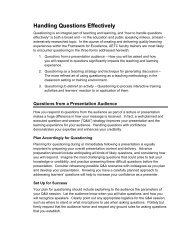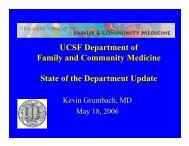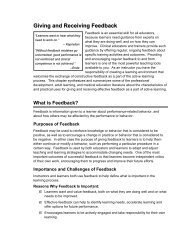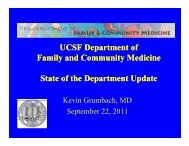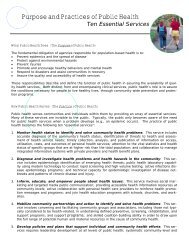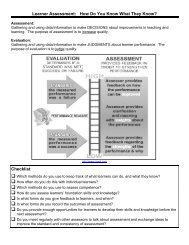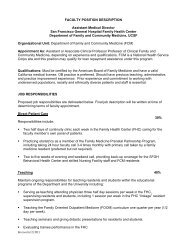Perspective and Experiences of Minority Faculty at UCSF
Perspective and Experiences of Minority Faculty at UCSF
Perspective and Experiences of Minority Faculty at UCSF
You also want an ePaper? Increase the reach of your titles
YUMPU automatically turns print PDFs into web optimized ePapers that Google loves.
<strong>Perspective</strong>s <strong>and</strong> <strong>Experiences</strong> <strong>of</strong><br />
<strong>Minority</strong> <strong>Faculty</strong> <strong>at</strong> the<br />
<strong>UCSF</strong> School <strong>of</strong> Medicine<br />
Megan Mahoney, MD<br />
Elisabeth Wilson, MD, MPH<br />
Kara Odom, MD, MPH<br />
Loma Flowers, MD<br />
Shelley Adler, PhD
Objectives<br />
• Background<br />
• Methods<br />
• Results<br />
• Conclusions<br />
• Implic<strong>at</strong>ions
Medical Workforce Diversity Research<br />
• Workforce diversity <strong>and</strong> medical educ<strong>at</strong>ion<br />
• Diversity in medical workforce improves health care quality <strong>and</strong> access to care<br />
for ethnic minorities<br />
• IOM <strong>and</strong> Sullivan Commission have called for measures to increase diversity in<br />
medical schools<br />
• Diversity in the medical student body enhances educ<strong>at</strong>ional experience for<br />
ALL students<br />
• <strong>Minority</strong> academic medicine faculty<br />
• Increase pipeline <strong>of</strong> minority medical students<br />
• Provide role modeling, mentorship <strong>and</strong> safe environment for medical students<br />
• Only 4.2% <strong>of</strong> medical school faculty n<strong>at</strong>ionwide<br />
• Less likely to hold senior rank, promoted <strong>at</strong> lower r<strong>at</strong>es, <strong>and</strong> report more<br />
discrimin<strong>at</strong>ion<br />
• Physicians <strong>of</strong> African descent experience “racial f<strong>at</strong>igue” which has personal<br />
<strong>and</strong> pr<strong>of</strong>essional consequences.<br />
• Ethnic majority <strong>and</strong> minority junior faculty <strong>of</strong>fer useful suggestions for<br />
addressing diversity <strong>and</strong> discrimin<strong>at</strong>ion issues.
• Minorities on campus<br />
<strong>UCSF</strong><br />
• Students (20%) > residents (9%) > fellows (7%) > faculty (5%)(<br />
• Current number <strong>of</strong> core faculty <strong>at</strong> <strong>UCSF</strong> SOM<br />
•1302 Caucasian<br />
•197 Asian-American<br />
American<br />
•40 L<strong>at</strong>ino<br />
•38 African-American<br />
American<br />
•44 N<strong>at</strong>ive-American<br />
• Diversity efforts in face <strong>of</strong> Prop 209<br />
• Many committees <strong>and</strong> task forces!
Methods<br />
• Qualit<strong>at</strong>ive study to explore difficult issues in-depth <strong>and</strong><br />
provide a voice for minority faculty<br />
• Recruitment<br />
• 76 invited for an interview<br />
• 48 agreed to be interviewed<br />
• 36 were interviewed<br />
• Semi-structured interviews<br />
• Questions about minority faculty experience, career<br />
advancement, discrimin<strong>at</strong>ion <strong>and</strong> diversity<br />
• Transcription: identifiers removed<br />
• Analysis: multiple investig<strong>at</strong>ors developed codes <strong>and</strong><br />
themes
Participants<br />
(n=36)<br />
Gender<br />
Female<br />
Male<br />
Race/ Ethnicity<br />
African American<br />
Asian/Pacific Isl<strong>and</strong>er<br />
Hispanic/L<strong>at</strong>ino<br />
<strong>Faculty</strong> Rank<br />
Assistant Pr<strong>of</strong>essor<br />
Associ<strong>at</strong>e Pr<strong>of</strong>essor<br />
Full Pr<strong>of</strong>essor<br />
Academic track<br />
Adjunct<br />
Residence<br />
Clinical<br />
Tenure<br />
Departments<br />
Anesthesia<br />
Emergency<br />
Family <strong>and</strong> Community Medicine<br />
Medicine, Primary Care<br />
Medicine, Sub Specialty<br />
Neurology<br />
Obstetrics/Gynecology<br />
P<strong>at</strong>hology<br />
Pedi<strong>at</strong>rics<br />
Prevention Studies<br />
Psychi<strong>at</strong>ry<br />
Surgery, General<br />
Surgery, Sub Specialty<br />
20<br />
16<br />
17<br />
3<br />
16<br />
16<br />
11<br />
9<br />
3<br />
2<br />
22<br />
9<br />
1<br />
1<br />
4<br />
10<br />
2<br />
1<br />
2<br />
1<br />
4<br />
1<br />
5<br />
3<br />
1
Results<br />
• Themes<br />
• Expect<strong>at</strong>ions<br />
• Mentorship<br />
• Discrimin<strong>at</strong>ion<br />
• Diversity Efforts
Expect<strong>at</strong>ions
Expect<strong>at</strong>ions<br />
[Among] African Americans, if you are any kind <strong>of</strong> pr<strong>of</strong>essional, there<br />
is th<strong>at</strong> added sense <strong>of</strong> responsibility, both <strong>at</strong> work <strong>and</strong> outside the home,<br />
th<strong>at</strong> you… need to be a role model.<br />
• African American man, senior rank<br />
I could show you the letter from the chancellor which said, “You’ve been<br />
appointed to the <strong>UCSF</strong> Diversity Committee.” …There was no question<br />
in there. It was more <strong>of</strong>, “This is when you’re going to start meeting.” eting.” I<br />
am sure I could have done something about it, but you pick your b<strong>at</strong>tles.<br />
• L<strong>at</strong>ino man, senior rank
Mentorship
Mentorship<br />
One <strong>of</strong> the things th<strong>at</strong> I've been encouraged to do is find a mentor, which<br />
I still haven't done. I feel partly it's because there aren't…there's ere's nobody<br />
like me in the department. There aren't really th<strong>at</strong> many other people p<br />
<strong>of</strong><br />
color.<br />
• African-American American woman, junior rank<br />
Being a minority faculty member cre<strong>at</strong>es a psychological stress for f<br />
a<br />
divergence <strong>of</strong> viewpoints… in th<strong>at</strong> there is always an uneasiness within<br />
social rel<strong>at</strong>ions in a dominant culture…I think th<strong>at</strong> psychological l stress<br />
can be relieved through appropri<strong>at</strong>e mentoring, but th<strong>at</strong> appropri<strong>at</strong>e<br />
<strong>at</strong>e<br />
mentoring requires a gre<strong>at</strong> deal <strong>of</strong> time.<br />
• L<strong>at</strong>ina woman, senior rank
Discrimin<strong>at</strong>ion
Discrimin<strong>at</strong>ion<br />
The discrimin<strong>at</strong>ion is much more subtle. It’s just hard to put a finger on<br />
it. It has to do with people in power, whether its your division chair, or<br />
your clinic director, or your department chair. It’s the convers<strong>at</strong>ions th<strong>at</strong><br />
take place…—it’s never a deliber<strong>at</strong>e <strong>at</strong>tempt to exclude anyone—th<strong>at</strong><br />
take place in informal circles.<br />
• African-American American woman, junior rank<br />
There’s been both subtle <strong>and</strong> overt racism. I have made a conscious<br />
decision about how much energy I was going to put into confronting ng those<br />
experiences, <strong>and</strong> have elected not to pursue them as much as probably<br />
somebody else would have.<br />
• African-American American woman, senior rank
Diversity Efforts
Diversity Efforts<br />
When you look <strong>at</strong> the color on the faculty, you see the lack <strong>of</strong><br />
commitment, <strong>and</strong> th<strong>at</strong> sends a message to the people we want to <strong>at</strong>tract<br />
tract<br />
into the university.<br />
• African-American American man, senior rank<br />
I think th<strong>at</strong> much more needs to be done. It needs to happen <strong>at</strong> much m<br />
more than these token levels where we have someone as a figurehead <strong>and</strong><br />
nothing else… We need to have some enforcement <strong>of</strong> policies. … We can<br />
have committee after committee study the problem, but unless there’s some<br />
me<strong>at</strong> behind the issue nothing’s going to happen.<br />
• L<strong>at</strong>ino man, senior rank
Diversity Efforts<br />
It's important to have an <strong>of</strong>fice <strong>of</strong> minority affairs where there is a visible<br />
place th<strong>at</strong> is going to solve problems…when we are recruiting students<br />
<strong>and</strong> faculty, there is a place where people can go <strong>and</strong> get inform<strong>at</strong>ion<br />
about wh<strong>at</strong> else is out there…Nobody is coordin<strong>at</strong>ing across all the t<br />
departments…Having an <strong>of</strong>fice, you can have an internal change agent<br />
th<strong>at</strong> can really keep their eye on the ball.<br />
• African-American American woman, senior rank
Conclusions<br />
<strong>Minority</strong> faculty members - both junior <strong>and</strong> senior - face conflicts<br />
between their personal experiences <strong>and</strong> institutional realities:<br />
1. In addition to a personal sense <strong>of</strong> responsibility towards their<br />
community, minority faculty are also faced with the external<br />
expect<strong>at</strong>ion th<strong>at</strong> they will provide represent<strong>at</strong>ion in various diversity<br />
ersity-<br />
rel<strong>at</strong>ed activities.<br />
2. <strong>Minority</strong> mentors help minority faculty navig<strong>at</strong>e the university structure s<br />
<strong>and</strong> institutional politics, however finding a mentor is difficult t given the<br />
lack <strong>of</strong> minority senior faculty.<br />
3. Though subtle, racial discrimin<strong>at</strong>ion occurs <strong>and</strong> has serious<br />
consequences in career p<strong>at</strong>h, research success, <strong>and</strong> retention in faculty<br />
roles. <strong>Minority</strong> faculty struggle with their response to experiences with<br />
discrimin<strong>at</strong>ion.<br />
4. Diversity efforts are recognized, but there is gap between intention tion <strong>and</strong><br />
implement<strong>at</strong>ion <strong>of</strong> these efforts. This gap cre<strong>at</strong>es the perception th<strong>at</strong><br />
diversity is not an institutional priority.
Implic<strong>at</strong>ions<br />
• <strong>Minority</strong> faculty are a useful resource for advising efforts to<br />
increase diversity in medical institutions.<br />
• An increase in the number <strong>of</strong> minority faculty is imper<strong>at</strong>ive to<br />
relieve the overburdening <strong>of</strong> current minority faculty <strong>and</strong><br />
achieve a critical mass necessary for recruitment <strong>and</strong> retention.<br />
• Time spent on mentorship <strong>and</strong> other diversity efforts is crucial<br />
but dem<strong>and</strong>ing, <strong>and</strong> should be recognized in the promotion<br />
process.<br />
• An Office <strong>of</strong> Diversity Affairs might help facilit<strong>at</strong>e the<br />
development <strong>of</strong> dedic<strong>at</strong>ed funding <strong>and</strong> measurement<br />
st<strong>and</strong>ards to apply towards diversity efforts.
Acknowledgments<br />
• Funding<br />
• Vice Chancellor’s Office<br />
• LEARN<br />
• Special Thanks<br />
• Loma Flowers<br />
• Eugene Washington<br />
• Rosalia Mendoza<br />
• Sha-nita<br />
Jones<br />
• Portia Jones<br />
• Jessica Muller<br />
• Laura Hill-Sakuri<br />
Sakuri<br />
• Marilyn Skaff<br />
• PARTICIPANTS!!
For more inform<strong>at</strong>ion<br />
contact Megan Mahoney or Elisabeth Wilson<br />
mmahoney@nccc.ucsf.edu<br />
ewilson@fcm.ucsf.edu




